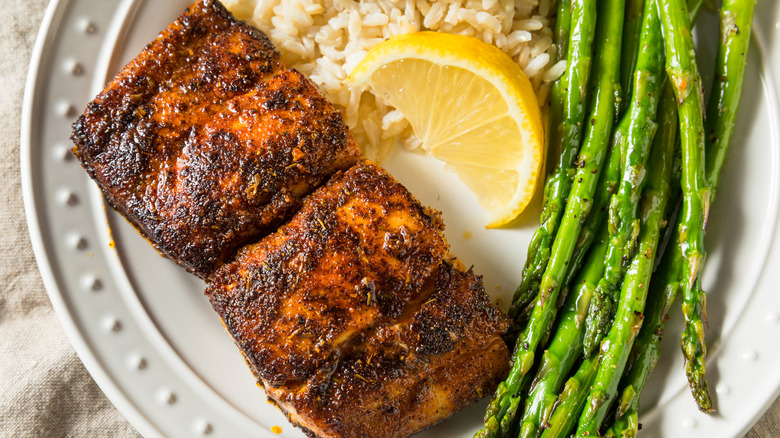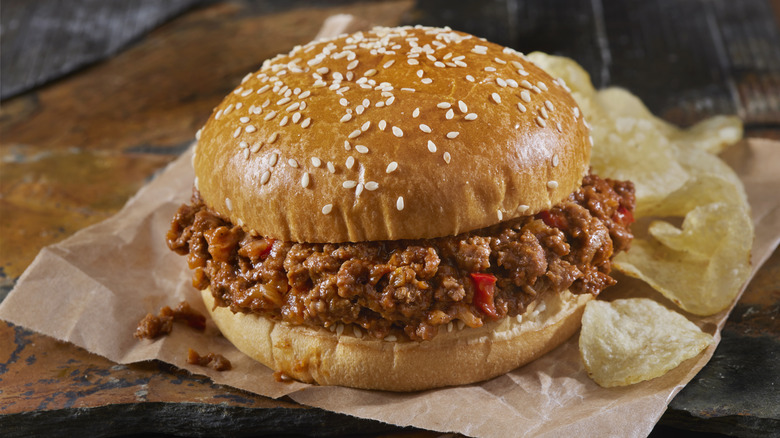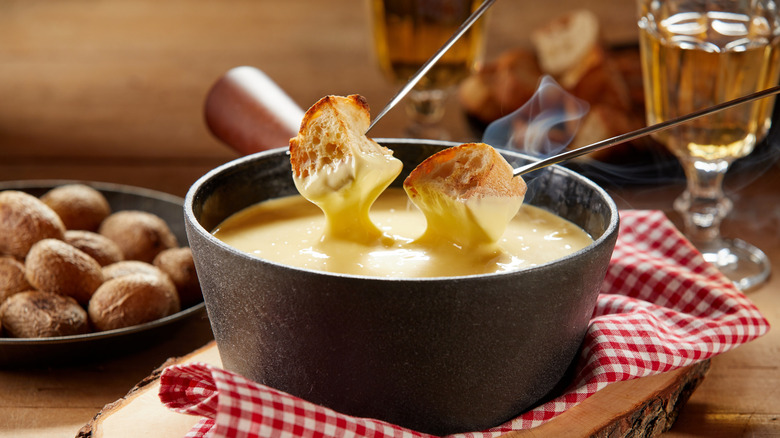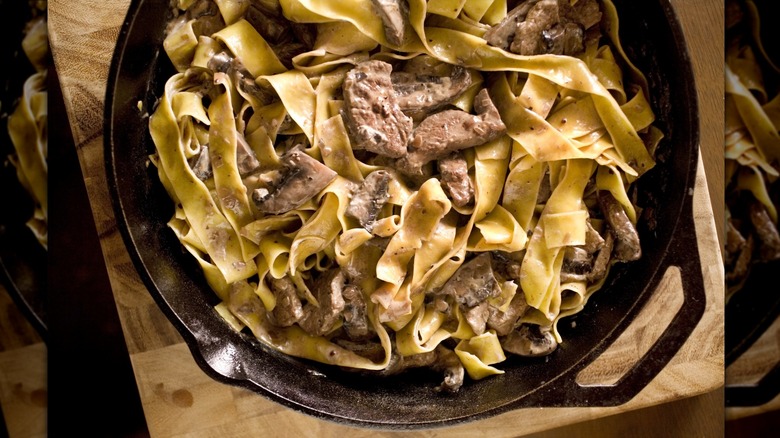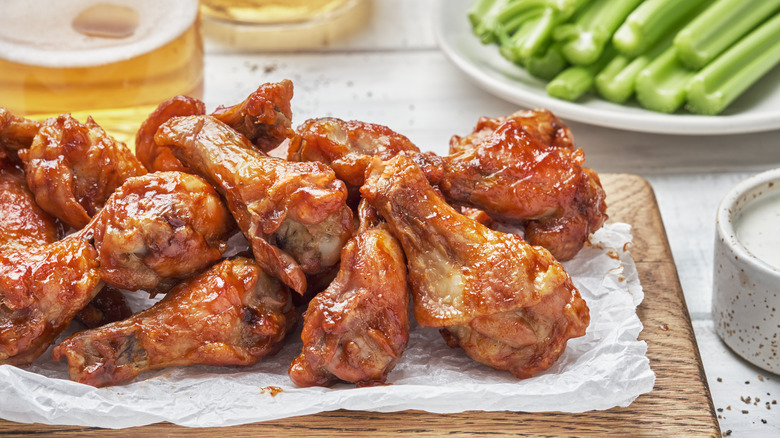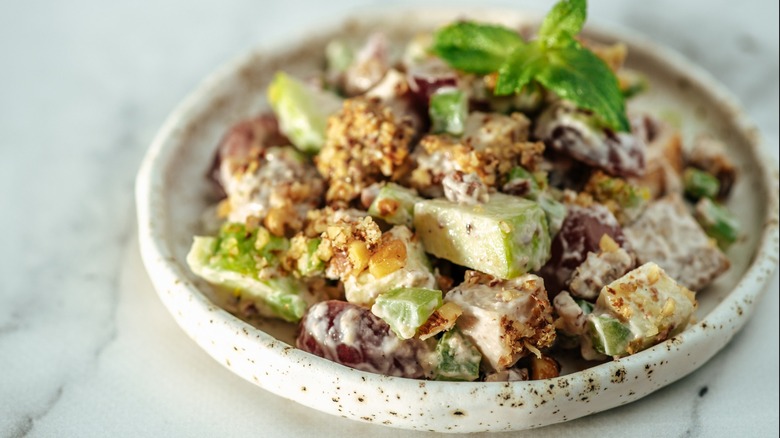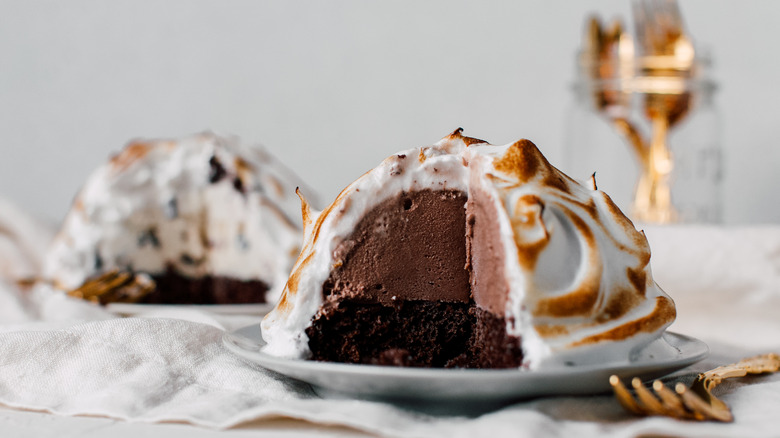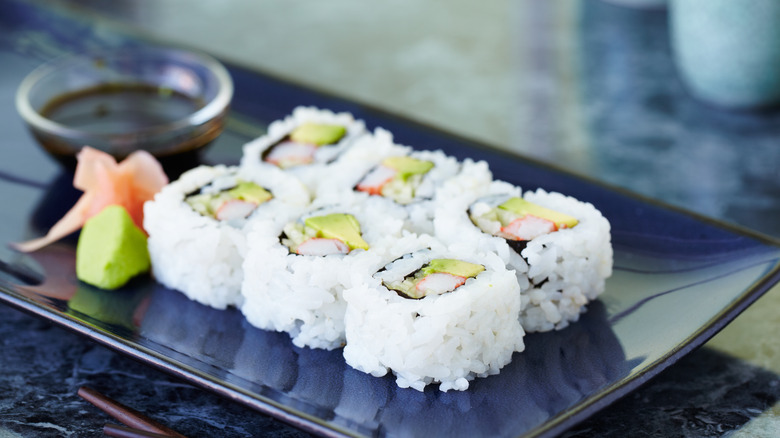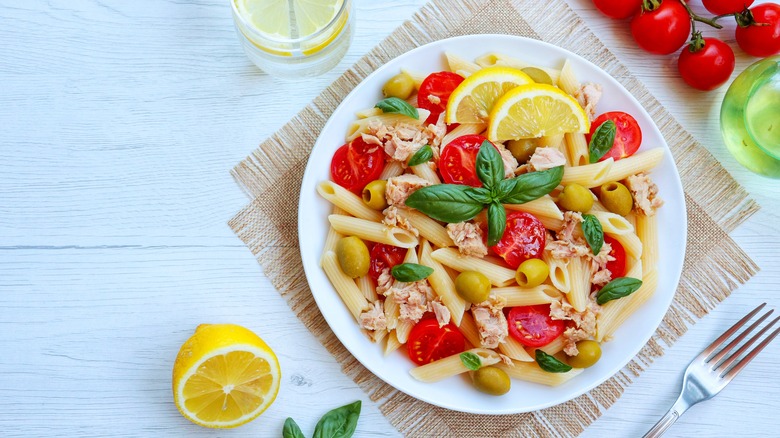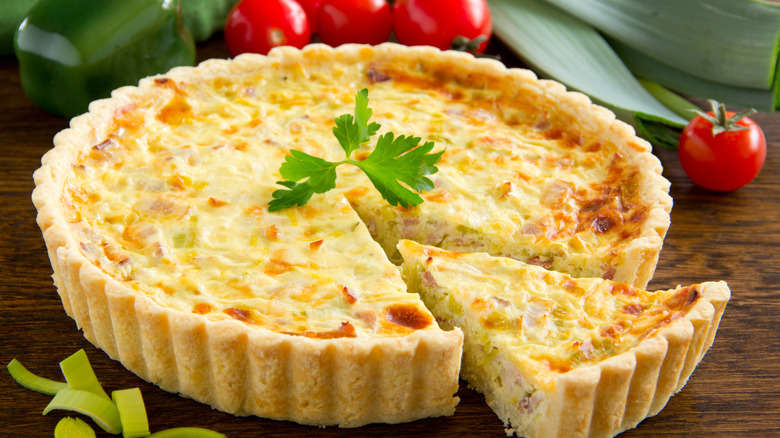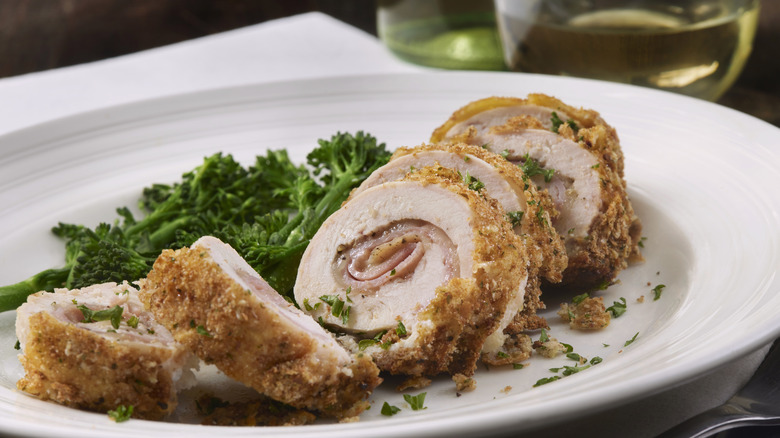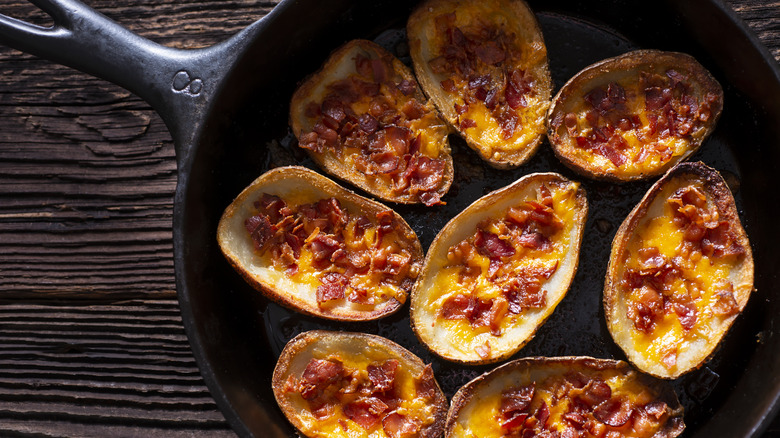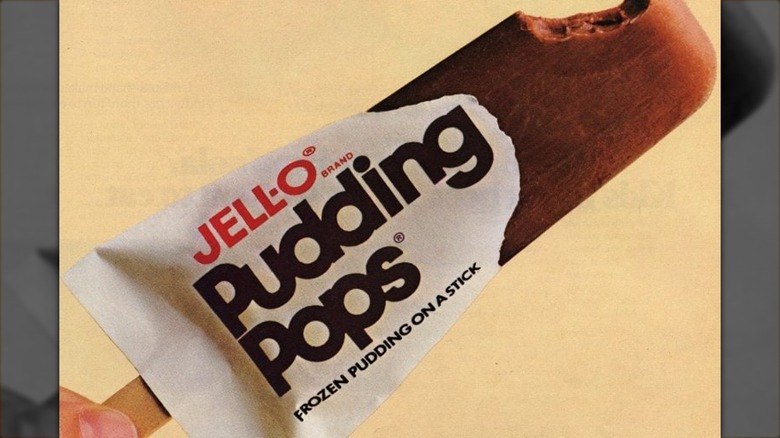13 Popular 1980s Foods People Are Eating Again
Who doesn't love to look back on some of our favorite foods from decades past? Whether you were a kid, a teen, or a grown-up, you know that the '80s were a decade filled with iconic fashion, music, and of course, some pretty amazing and over-the-top food. While some of these culinary trends have come and gone, we know that what goes around comes around. Today, the foods that captured '80s excess are making a comeback in the culinary world and demonstrating just how timeless they really are.
Lately, food enthusiasts of all stripes are rediscovering all kinds of '80s flavors, from trendy fine dining dishes to nostalgic meals mom used to make. And while some of the more enduring dishes remain unchanged, others are getting a simpler or more attractive facelift in the modern era. From nostalgic comfort foods like Sloppy Joes and pudding pops to showy fine dining classics like quiche Lorraine and baked Alaska, we invite you to enjoy a trip down memory lane, or discover some of these "radical" meals for the first time!
1. Blackened fish
One of the true superstars of the '80s culinary scene, blackened fish became a national sensation when first introduced to diners in New Orleans. A creation of renowned Louisiana native Chef Paul Prudhomme, the dish would inspire an entire wave of Cajun and Creole-fusion dishes and a massive trend of blackening seafood.
Prudhomme created the blackening technique by dipping redfish in melted butter, and coating it with a generous and mouthwatering blend of spices, such as paprika, cayenne pepper, garlic powder, and thyme. The seasoned fillets were then seared to perfection in a scorching hot cast-iron skillet, creating a charred and spicy crust while sealing in the natural juices of the fish.
As word of this delectable dish spread, restaurants nationwide began offering their own variations of blackened fish, using different types of fish fillets to accommodate regional preferences and seafood availability. This groundbreaking creation gave way to a trend of blackened fish in restaurants nationwide. While the original recipe utilized the native catch of redfish, other fish were well suited to blackening, like salmon, catfish, trout, and snapper.
Blackened fish did fall out of favor, eventually. Part of the reason was that the dish was so popular that redfish was being overfished in the Gulf Coast and the redfish population took over a decade to recover. Today, it's coming back in a big way for health-conscious home cooks, since fish is such a great source of protein and omega-3 fatty acids.
2. Sloppy Joes
It's indulgent, messy, and a total nostalgia bomb. A cherished '80s comfort food, Sloppy Joes earned its place in the hearts and homes of families across America with its messy and savory deliciousness. This humble, simple sandwich quickly became a lunchroom classic.
The origin of the Sloppy Joe is not fully known, but we do have some hints about its inherently Midwestern beginnings. According to John F. Mariani in his "Encyclopedia of American Food and Drink," loose meat sandwiches similar to Sloppy Joe's date back at least to the 1930s in Sioux City, Iowa. In the '80s, Sloppy Joes saw an uptick in popularity because they were a cheap and easy dinner idea for busy families, especially when using canned sauces like Manwich.
At its core, there's nothing complicated or mysterious about a Sloppy Joe. It all starts with seasoned ground beef or turkey, which is combined with a rich and tangy tomato-based sauce. The mixture is then served on classic hamburger buns, sometimes with a slice of American cheese, pickles, or cole slaw.
Over the years, the Sloppy Joe has been given more than a few makeovers, which help it remain a timeless classic and favorite for generations. From plant-based and vegan versions to gourmet options featuring high-quality ingredients, the simplicity of the Sloppy Joe is what makes it so versatile.
3. Fondue
There's nothing like a fondue pot to bring people together. In the late '70s and '80s, this interactive and engaging dining experience gained widespread popularity, bringing friends and families together around a communal pot of melted cheese or chocolate.
Traditional Swiss cheese Fondue is made by melting and blending multiple cheeses, like Gruyère and Emmental, with garlic and white wine, which makes for an indulgent and decadent dip. Diners use long-stemmed forks to skewer pieces of crusty bread, which are then dipped into the molten cheese, creating a flavorful and interactive feast. Particularly in the '80s, meat fondue became a big hit by adding a bit more interactive appeal to the dish. Thinly-sliced pieces of meat like beef or chicken would be cooked in oil or broth right at the table using camping stovetops. The fondue pot itself was usually heated with a candle placed underneath it.
Today, fondue is experiencing a delightful resurgence at parties, reunions, and get-togethers inviting friends and family to gather around the melting pots and savor the delightful dippable bites. The dish's revival also owes much to how versatile it is by nature –- modern hosts can customize the experience to suit diverse tastes and dietary preferences.
4. Beef stroganoff
Yes, '80s kids everywhere remember this simple plate of beef, gravy, and noodles that mom used to make. Originating from Russia, this culinary gem made its way into the spotlight during the '80s as a comforting and flavorful food that played the starring role in many a family dinner. The dish's exact origins remain somewhat mysterious, with several accounts attributing its creation to various members of the Stroganov family, a prominent Russian noble dynasty.
In its classic preparation, thin strips of beef are sautéed to tender perfection, alongside onions and mushrooms. The trio is then simmered in a velvety, rich sauce made with sour cream and sometimes enriched with beef broth or white wine. The result is then served on top of noodles, where the succulent beef melds with the savory mushrooms and the tangy cream sauce, while the noodles give the dish a hearty appeal.
Today, modern foodies are rediscovering the heartwarming nostalgia of this classic dish, as it makes a triumphant return to their hearts and kitchens. The timeless nature of Beef Stroganoff lies in its ability to deliver a filling comfort meal, offering a taste of both tradition and indulgence, making it an ideal choice for both special occasions and everyday dining.
5. Buffalo wings
The story behind these spicy delights takes us back to Buffalo, New York, in 1964. The original Buffalo wings were introduced by Teressa Bellissimo, the owner of the Anchor Bar, who ingeniously transformed leftover chicken wings into a spicy, savory, and oh-so-satisfying masterpiece.
To create Buffalo wings, the wings are deep-fried to crispy perfection, achieving an irresistibly crunchy texture on the outside while remaining tender and juicy on the inside. But the real magic lies in the bold and tangy Buffalo sauce, a heavenly concoction of hot sauce, cayenne pepper, Worcestershire sauce, vinegar, and melted butter. Once the wings are fried, they're tossed in this iconic sauce that gives them a punch of heat that balances perfectly with ranch dressing and celery sticks.
In the present day, Buffalo Wings continue to tantalize taste buds, with restaurants and home chefs alike putting their own creative spins on the classic. Variations in heat levels, dipping sauces, and accompanying sides have expanded the horizon of these wings, ensuring that they remain a must-have for any gathering, game night, or casual meal to this day.
6. Waldorf salad
Named after the iconic Waldorf Astoria Hotel in New York City after it opened in 1893, the Waldorf salad has been a staple item for any upper-crust dining menu for over a century. The salad's creation is credited to Waldorf Executive Chef Edouard Beauchamp and hotel maitre d'hotel Oscar Tschirky, who debuted this now-classic dish at the Waldorf's first charity function. But it particularly captured the culinary spotlight in the '80s, when chefs and cookbook authors alike tried to update and refresh the original recipe.
The Waldorf salad's straightforward recipe revolves around a refreshing mix of crisp apples, celery, grapes, and walnuts, all bound together with a creamy mayonnaise dressing. The combination of sweet, tangy, and nutty flavors creates a delightful contrast that immediately captivated diners, making it a resounding success on hotel menus that require meals that can be easily and quickly prepared while still looking impressive.
Over the years, the Waldorf salad has evolved, embracing modern twists that cater to contemporary preferences and dietary restrictions. Today, health-conscious diners will find comfort in the salad's nutritious blend of fruits and nuts, while the creamy dressing can be adapted to healthier alternatives like Greek yogurt.
7. Baked Alaska
What other dessert could exude the extravagance and excessive flair of the '80s better than a Baked Alaska? While no one knows exactly who cooked the very first Baked Alaska, the recipe that we know today was developed by Chef Charles Ranhofer in 1867 when he served a dessert that he called an "Alaska, Florida" to celebrate the recent purchase of the Alaska territory from Russia.
This unique multi-layered dessert is built on a base of light and airy sponge cake, providing a sturdy foundation for a generous layer of ice cream that is traditionally sculpted into a dome. The entire creation is then covered in a fluffy meringue that is expertly swirled into a cloud-like appearance.
But the real showmanship of the Baked Alaska lies in the baking process. The meringue is toasted to a golden brown, creating a dramatic contrast between the warm, toasty exterior and the chilly, frozen interior. It's impressive even today, but imagine such a feat when freezers, refrigerators, and electric ovens weren't available!
Baked Alaska is considered a vintage dish today, but that doesn't mean it's disappeared entirely. Today, chefs, influencers, and home cooks alike are taking on the classic dessert and giving it a streamlined makeover, either by creating small personal-sized versions or by making a simple sheet cake version.
8. California roll
Would you believe that sushi wasn't always the insanely popular meal that we know and love? In fact, while a rice and fish meal similar to sushi has been made in China and Japan for thousands of years, the first "modern" nigirizushi was created in the early 19th century by chef Yohei Hanaya when he discovered a new way to prepare sushi using vinegar and topping it with a piece of tuna.
Modern-day sushi was introduced to America in the 1920s, but it wasn't until the middle of the 20th century that it experienced a global takeover. The California Roll played a significant role in introducing this beloved Japanese cuisine to a wider audience beyond Japan because it was simple, approachable, and used ingredients that Americans were familiar with.
The California Roll is a quintessential Americanized sushi roll, catering to the palates of sushi novices and aficionados alike. This roll features a seaweed-wrapped rice roll filled with imitation crab, creamy avocado, and crisp cucumber. The combination of mild and refreshing flavors, combined with the familiar textures of avocado and cucumber, makes it a perfect entry point for those new to sushi.
Diners have the freedom to enhance the roll to suit their preferences by adding wasabi, soy sauce, sriracha, or other condiments. This adaptability has allowed the California Roll to become an easy gateway into the world of sushi and encourages curious eaters to explore other kinds of traditional sushi rolls and nigiri.
9. Pasta salad
With its vibrant colors and refreshing taste, pasta salad became a summertime staple of '80s picnics, potlucks, and barbecues. Its popularity soared thanks to its colorful presentation, tantalizing flavors, and adaptability, not to mention how easy it is to make.
There are countless variations and personal touches that can be added to create your unique and flavorful pasta salad, but most versions of this dish have a few things in common. Typically, pasta salads feature cooked pasta, such as rotini, fusilli, or penne, tossed with an assortment of fresh vegetables like cherry tomatoes, bell peppers, cucumbers, and olives. The medley of colors adds visual appeal, while the zesty vinaigrette gives the salad a delightful tanginess.
The timeless charm of pasta salad lies in its ability to cater to diverse tastes, accommodating vegetarian, vegan, and gluten-free diets, making it an inclusive and crowd-pleasing dish. As summer picnics and outdoor gatherings remain beloved traditions, pasta salad continues to hold its position as a delightful and customizable centerpiece on any menu.
10. Quiche Lorraine
Remember when quiches were all the rage? We often think of quiches as a somewhat vintage or dated dish, but back in the '80s, these pie-meets casserole dishes screamed sophistication. You could find a quiche in just about any restaurant or cookbook, and leading the pack was the flavorful, flakey Quiche Lorraine.
The quiche is believed to have its roots in Germany, but this variation comes from the Lorraine region in France and has become synonymous with French cuisine. The traditional recipe features a delectable mixture of eggs, cream, bacon, and Swiss cheese. The light and fluffy filling contrasts beautifully with the crisp and flaky crust, making every bite an indulgent experience.
Today, Quiche Lorraine is making a delicious comeback, with home chefs infusing new life into this timeless dish. Elevating the traditional recipe, modern renditions of Quiche Lorraine often incorporate gourmet ingredients like gruyere and prosciutto to enrich the flavor profile of this classic.
11. Chicken Cordon Bleu
Initially a Swiss creation, Chicken Cordon Bleu experienced a surge of popularity during the '80s, emerging as a culinary superstar when a recipe for it was published in the "Good Housekeeping Illustrated Cookbook" in 1980. This dish elevates a simple chicken breast to new heights, turning it into a rich and flavorful meal.
The preparation of Chicken Cordon Bleu involves wrapping a tender chicken breast around savory ham and Swiss cheese. The chicken is then breaded to achieve a crisp and golden exterior, while the inside remains succulent and filled with cheesy goodness. The result is a dish that impresses both in presentation and taste, with a pinwheel spiral design once you cut into it.
Since its peak in the '80s, Chicken Cordon Bleu has made a transition from a fine-dining favorite to a weeknight family dinner. As culinary trends evolve, the dish is getting a streamlined makeover, becoming a simple and easy one that can be prepared with minimal effort. Home cooks are finding creative ways to preserve the elegance and flavor of this dish while making it more accessible for everyday meals.
12. Potato skins
The idea of this must-have appetizer came mostly out of necessity –- it was a way for cooks to use up leftover potato peelings that were going to waste every night. There are a few different restaurants that claim to have come up with the "original" potato skin: Prime Rib Restaurant in Washington, DC; Chicago restaurant R.J. Grunts; and the casual fast food chain T.G.I. Friday's. They came about in the late '70s, and by the next decade, they were a massive casual dining hit.
There's nothing really complicated about this appetizer, so they're easy to make at home. Potato skins are essentially a mash-up of fries and potato chips; hollowed-out potato shells are baked until they're crispy and golden brown, with a soft potato center. But the toppings are really what help make this dish shine. Most potato skins are topped with melted cheese, bacon bits, chives, sour cream, and hot sauce.
These deliciously crispy shareables have been a mainstay of casual cuisine since their inception, and have never really gone away. In fact, they're still a popular app in restaurants and house parties alike, likely due to how versatile they can be. But contemporary foodies are giving this classic a gourmet spin with luxurious ingredients like brie, prosciutto, leeks, or cremini mushrooms.
13. Jell-O Pudding Pops
While the very first ads for Jell-O's signature pudding pop can be traced back to 1967, there's no doubt that its popularity peaked in the '80s. These iconic treats featured smooth and creamy Jell-O pudding frozen onto a stick, providing a burst of indulgent and icy-cold refreshment that made them an instant hit with kids and adults alike. They were helped along with a massively successful commercial campaign featuring comedian Bill Cosby.
Jell-O Pudding Pops gained a devoted following during their heyday, and today they evoke a bit of a nostalgic feeling. Unfortunately, despite their popularity, these beloved frozen treats were eventually discontinued in 2004, leaving fans longing for their return.
However, nostalgia for our favorite childhood treats knows no bounds, and people today are embracing the fond memories of Jell-O Pudding Pops by taking matters into their own hands. Many creative food enthusiasts have found a way to relive the joy of these frozen goodies by making their own pudding pop versions at home. By using silicone freezer molds and preparing Jell-O pudding according to the package instructions, you can recreate the magic of the past and enjoy a delightful throwback to simpler times.

